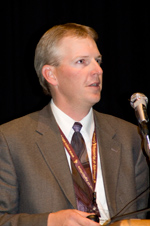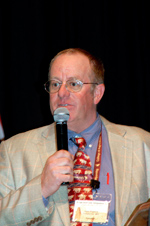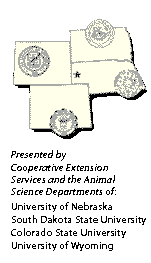Set Priorities, Make Decisions
Two ranchers share insight from their cattle operations.
by Kindra Gordon for Angus Productions Inc.
CASPER, Wyo. (Dec. 3, 2009) — Doug Olsen of Harrisburg, Neb., and John Francis of Cheyenne, Wyo., shared comments about how they’ve established priorities to better add efficiencies — and profitability — to their cattle operations as they addressed attendees at the 2009 Range Beef Cow Symposium.
 Doug Olsen said priorities for their herd established over the last several years include a focus on progeny testing, retained ownership, grazing systems and a switch to a summer calving date.Olsen Ranches Inc. is a fourth-generation family business with a Hereford and Red Angus commercial beef cattle operation. The Olsens retain ownership of the cattle through harvest. They also farm and raise cereal grains.
Doug Olsen said priorities for their herd established over the last several years include a focus on progeny testing, retained ownership, grazing systems and a switch to a summer calving date.Olsen Ranches Inc. is a fourth-generation family business with a Hereford and Red Angus commercial beef cattle operation. The Olsens retain ownership of the cattle through harvest. They also farm and raise cereal grains.
Olsen emphasized how important it is to take the time to identify the things that are priorities to your operation.
“The priorities you identify affect the long-term multi-generation direction of your operation,” he pointed out. “I would suggest most of us need to spend more time analyzing information and data before we make decisions.”
The priorities his family has established over the last several years include a focus on progeny testing, retained ownership, grazing systems and a switch to a summer calving date. Presently, they are the primary reference herd for the American Hereford Association’s National Reference Sire Program. “This fit with our passion for genetic improvement for our herd and the beef industry,” he explained. They intend to add a GrowSafe facility for measuring feed efficiency to their operation in 2010.
 John Francis shared that in his operation a priority for developing quality F1 replacement females led him to a three-way partnership with Lerwick and 5L Red Angus ranches.Olsen noted that many of their priorities complement one another. “Our grazing system complements our AI and calving date.” He acknowledged that priorities are unique to each producer as every operation is different, but he stressed the important thing is taking time to identify those priorities.
John Francis shared that in his operation a priority for developing quality F1 replacement females led him to a three-way partnership with Lerwick and 5L Red Angus ranches.Olsen noted that many of their priorities complement one another. “Our grazing system complements our AI and calving date.” He acknowledged that priorities are unique to each producer as every operation is different, but he stressed the important thing is taking time to identify those priorities.
Similarly, John Francis shared that in his operation a priority for developing quality F1 replacement females led him to a three-way partnership with Lerwick and 5L Red Angus ranches. Red Angus heifers are purchased from the 5L Red Angus ranch, Francis then breeds them to Hereford sires to produce red baldie F1 progeny. The baldie heifers are then sold to Lerwick Ranch and bred to Charolais bulls to fit their terminal program.
Francis reports that the program is returning more money to all three ranches involved and adding efficient genetics. As an added benefit, he is reaping $75 more per red baldie steer because of the increased weight from the heterosis. “I really believe this program is going to work for all three ranches involved,” he concluded.
Editor’s Note: API's coverage of the event is made available for distribution to all media via an agreement with the Range Beef Cow Symposium Committee and API. Headquartered in Saint Joseph, Mo., API publishes the Angus Journal, the Angus Beef Bulletin, the Angus Beef Bulletin EXTRA, and the Angus e-List, as well as providing online coverage of events and topics pertinent to cattlemen through the API Virtual Library. For questions about this site, or to notifiy us of broken links, click here.
